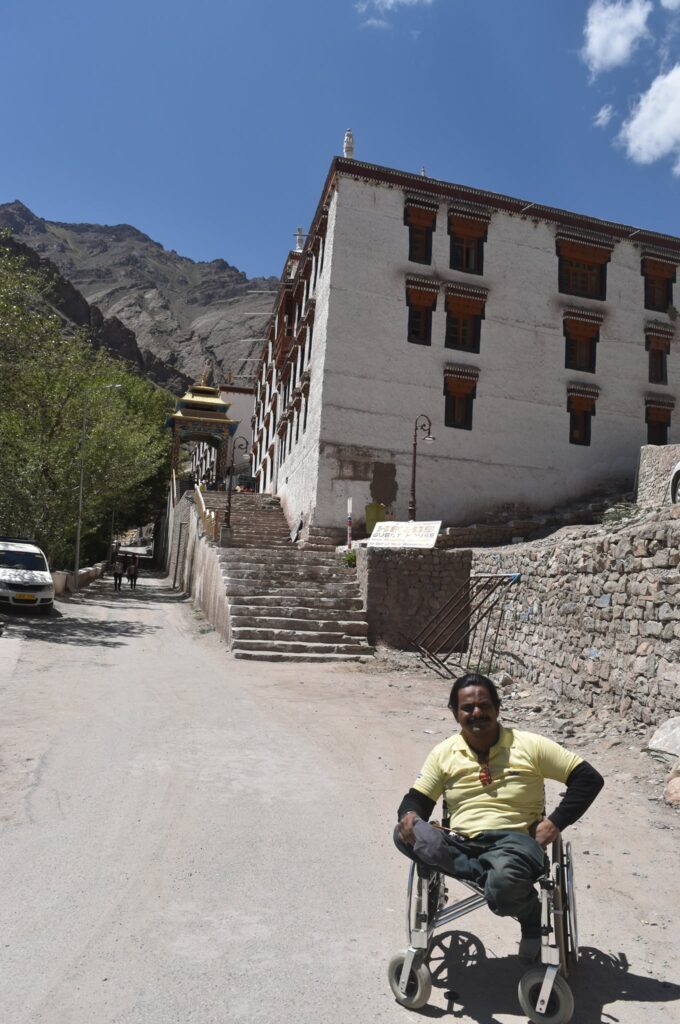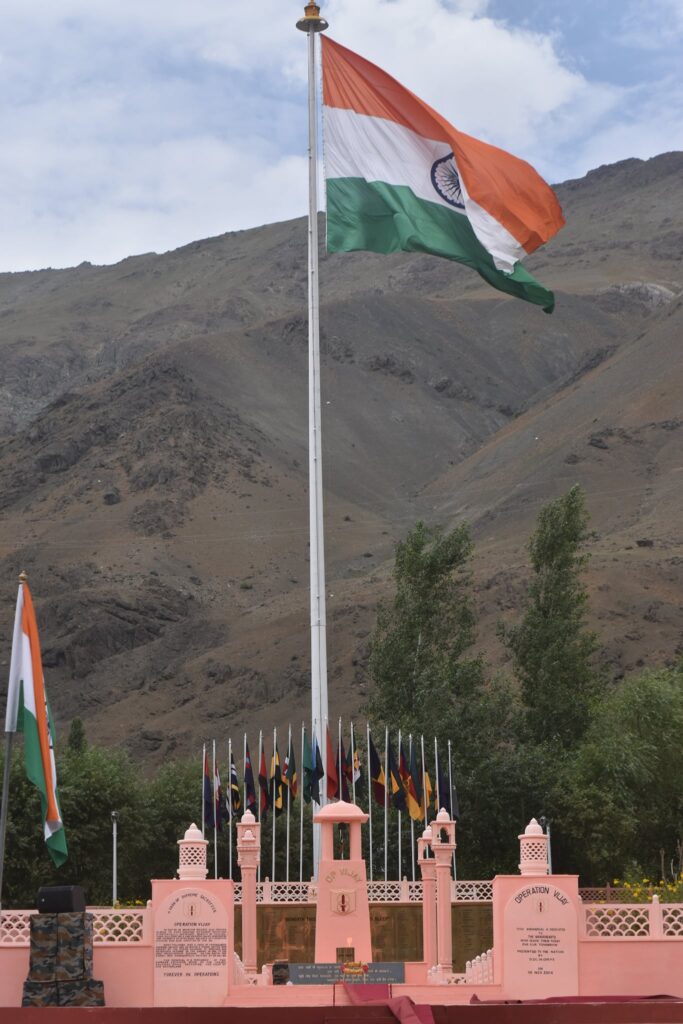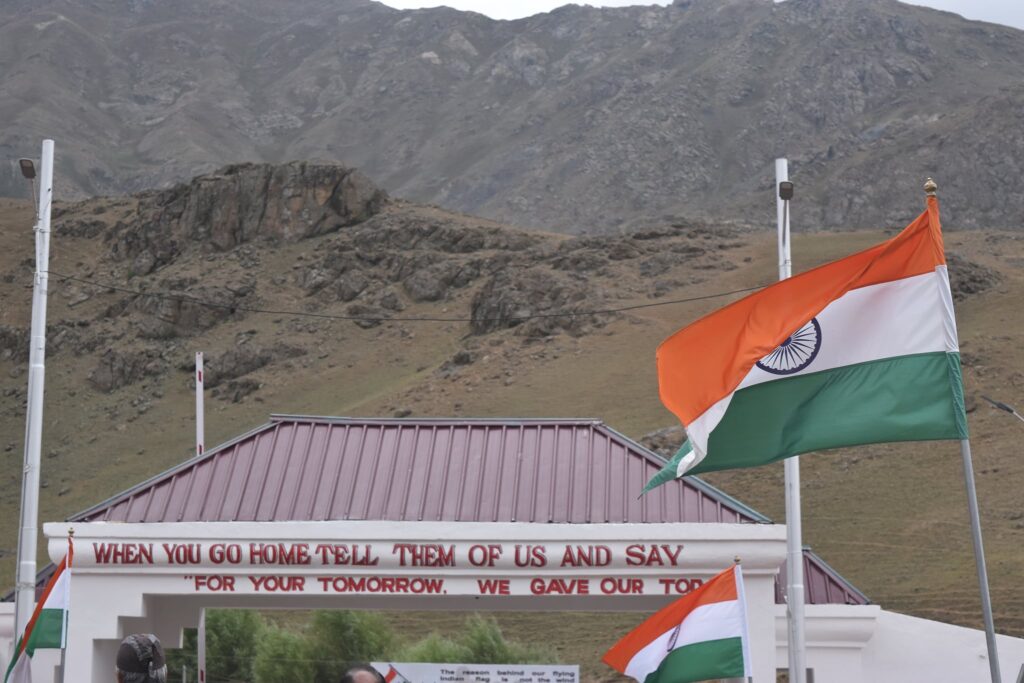Even before we landed at the Leh airport, the mesmerizing beauty of rugged mountains greeted us through the tiny window of the plane. As the sun rose from one side of the plane, the snow of the mountains glittered even more. We had traveled to the crown jewel of India.
Leh is populated with about 35000 Buddhist and Muslim residents. A tiny cheerful town settled in the laps of mountains. Since we visited in the summer, these mountains were bare, naked, and had stories to be told about the harsh winters they’d endured. Beyond them, there was another range of the mountains still clad with layers of snow. We had a panoramic view of the Himalayas at our disposal throughout our stay at Leh. being situated at about 3500 feet high, the term “breathtaking” was also applied in the literal sense of the term. We were immediately out of breath when we landed at the airport, (well, not all but I and a few of the other mortals who traveled with me).
While we traveled through the town in the early morning of the day, you can’t help but notice the simplicity in everything. The houses built with a similar structure to the window or the construction style would be the same across all the houses. One might even wonder if anyone can distinguish between a rich man’s bungalow and a poor man’s residence. The roads were narrow, and populated with small vendors opening their shops. Kids in school uniforms walk toward their schools. Men and women in their traditional attire wait for some sort of transport to reach their destination. All in harmony. There was no honking or noise. It felt like all parts of the machine were at the right place here. Nothing felt rushed. It had its own pace and this feeling continued to be there throughout the time I spent in Leh. While you cross the main bazaar area, you meet with the impressive statue of the king of Leh. Then a simple monument for Colonel Sonam Wangchuk of the Ladakh Scouts- The Soft-Spoken Buddhist Soldier from Ladakh, who Notched India’s First Win in Kargil (Google about his heroic win)
Chapter 1: The Smile That Owned Our Hearts

It takes some time for our body to adjust to the thin air, we were told. So, we slept the first day in the hotel helping ourselves to get acclimatized. At about 5 PM post a delightful afternoon nap and lovely family time, we declared we were acclimated alright. So we headed out to explore the slow-paced, smiling town of Leh, others on foot and me in my wheelchair, as much as we could. Just 1 km on the road, we were parched. We thought probably we shouldn’t have exerted. “only if we could get a hot cup of tea”, my partner said. So our mission changed from exploring Leh to finding a tea shop. Obviously, there were no Starbucks or CCDs around, so we had to resort to asking locals for directions where we could get tea. One café was signaled out and we decided to head out there. while we waited for the café to be opened, a welcoming family, with love invited us to have tea in their house instead of waiting on the side of the road. But we politely declined as we didn’t intend to disturb them. Soon enough the café opened and we eagerly asked for tea. It was served without any hesitation and with an equally warm smile. We had forgotten an important detail while we walked out of the hotel. We had no cash with us. there was no mobile signal so we couldn’t transfer money digitally too. I felt really embarrassed about the situation but the owner of the café held the same smile and said no worries. He said it’s OK if we don’t pay whereas I begged him to either come with me to the hotel. He didn’t look too bothered about it. His smile won our hearts.
With a promise that I shall surely pay him before I leave Leh, we left. Eventually, on the 7th day, we had some time off and we could finally go to the same café to pay him back. The owner was delighted that we visited him one more time than for the money we gave him. During the trip, I was again and again reminded that this place is beautiful; not only due to nature but also due to its resident’s hearts.
Chapter 2: for your tomorrow, we gave our today
In May 1999, the Pakistani army breached the Simla accord and entered the Indian territory with the mindset to blow the NH1 to pieces. This will ensure that JnK is cut off from India and it would be an easy walkover for the Pak army when they attack. for this purpose, they needed to ensure they had control of the mountain peaks, which oversee the area of Kargil. They entered from the tiger hill and sneaked onto various key high positions. On 3rd May, A Pakistani intrusion in the Kargil district was reported by local shepherds to the Indian army. Post that 5 soldiers who were sent for surveillance were brutally killed by the Pak army and the conflict ignited from thereon.

No matter how many times you hear, read see these stories, they are nothing compared to the visit to the Kargil war memorial. As the gate opened for my wheelchair to pass, it opened to a flag as high as the sky, fluttering in the blue sky against these very mountain peaks where the Indian army fought a battle against a hidden enemy. You can see the IAF MIG which was instrumental in the Kargil war along with various guns used to rain fire on the hilltop by the Indian army, proudly stationary at the memorial. There also lays a site of 527 soldiers who gave their lives to our country and various heroes, whose statues stand tall with pride. Reading brief text on their monuments, makes you lose track of time. Each of the plaques had stories of unbelievable courage and valor.
A soldier asked everyone to gather around for the tale of war. He told pointing to each of the peaks, identifying them with names and the story of how the blood was spilled on them. We wept like a child hearing how these battles were fought. How our young men climbed on the mountain from various directions to mislead the enemy. How they hid behind rocks when the cowards from the top opened up fire. When there was heavy shelling, our soldiers chose to stay in the middle of the mountains for a few days without food rather than coming back to base. They climbed in the dead of the night so that on a windy morning they could have the element of surprise. How after hearing our roaring lions, the mice retreated!
Without notice, my hand went to salute the fluttering flag and the mountain that witnessed the war. With a heavy heart, I touched the ground where these young men lost their lives. when I turned back to move out of the memorial, here at the top of the door read a message – when you go home, tell of us and say, for your tomorrow, we gave our today”
A poster near the main entrance read – “the reason behind our flying Indian flag is not the wind behind it, but it is the breath of each and every soldier which keeps it flying high.”
I felt numb. I was lost in the thoughts of these men, their stories. From then on wherever I saw the Indian flag, I think of this day, their sacrifice, their smiling faces in the photos. I turned back to see the enormous mountain where this battle was fought and again saluted the men who will never be forgotten.
At the far left of the site, in the corner, the Tiger Hill peak was touching the sky, a symbol of the impossible tasks achieved by our brave men. If only Tiger Hill could speak to us about the war as it had the best vantage point of how the Indian Army won what was rightfully theirs.

